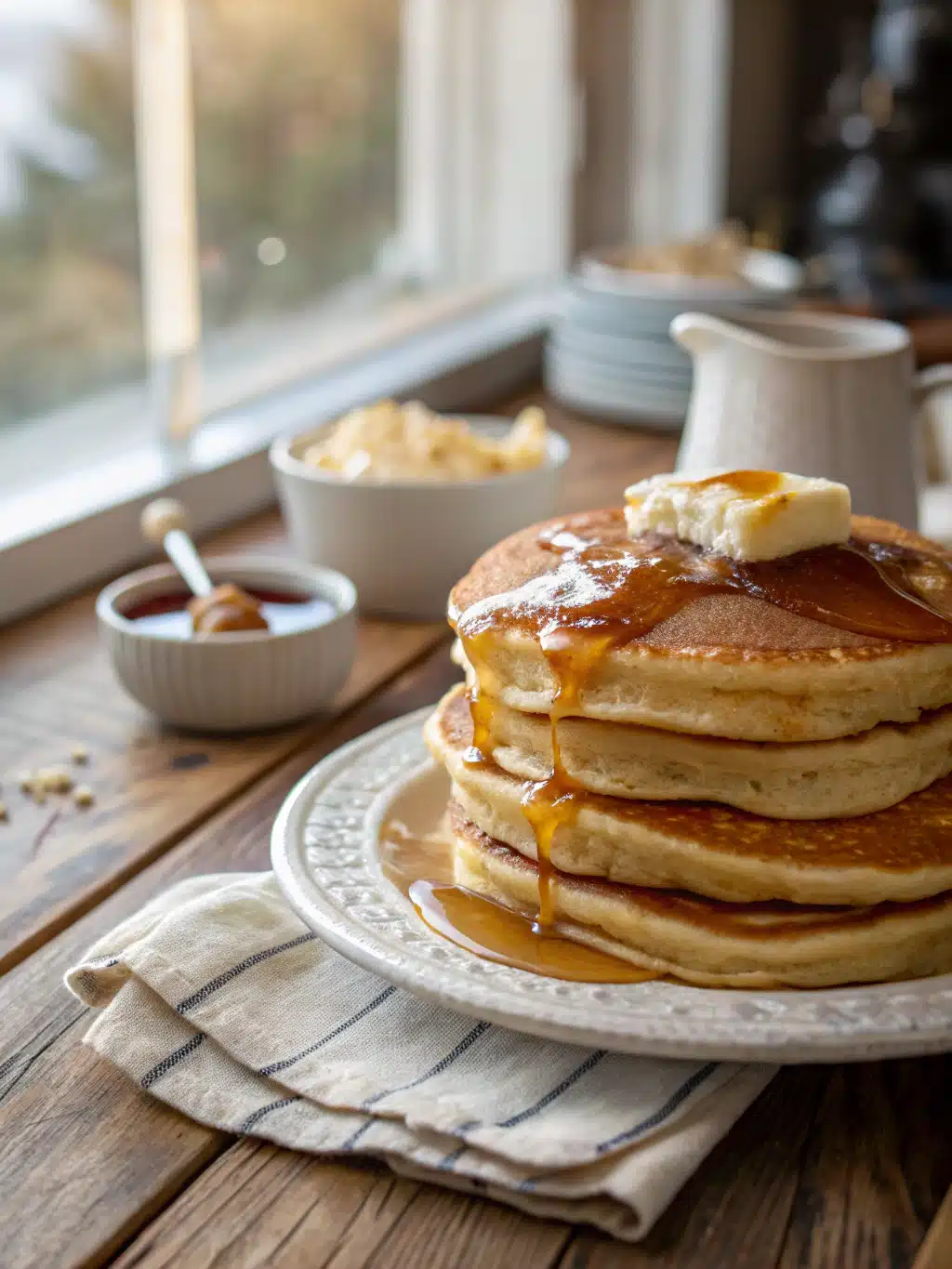Table of Contents
There’s something about a Saturday morning that practically begs for pancakes. This recipe came out of those relaxed weekends when the family gathered, everyone hungry, and expectations high. After testing countless mixes, tricks, and griddle temperatures, one thing became clear: making perfect pancakes isn’t about luck—it’s about technique and balance. Whether you’re cooking for little ones or hosting a lazy brunch, having a reliable pancake recipe is essential. With a few smart tips and pantry basics, your pancakes can turn out golden, fluffy, and irresistible—every single time. In this guide, we’ll cover exactly how to master the art of perfect pancakes.
The Secret to Perfect Pancakes
Understanding the Science Behind Pancake Batter
At its core, the secret to perfect pancakes lies in the batter. Pancake success starts with achieving the right ratio of wet to dry ingredients. Too much liquid, and you’ll end up with flat, rubbery rounds. Too much flour, and they turn dense. To get it just right, mix 1½ cups all-purpose flour with 1 tablespoon baking powder, a pinch of salt, 2 tablespoons sugar, 1¼ cups milk, 1 egg, and 3 tablespoons melted butter. Stir until just combined—lumps are not only okay, they’re actually a good sign you haven’t overmixed.
Overmixing activates the gluten in the flour, which is great for bread, but not for pancakes. The more you stir, the more gluten forms, which can toughen your results. To get pancakes fluffy on the inside and golden on the outside, mix gently and let the batter rest for 5–10 minutes before using.
“Pancakes are a balance of chemistry and intuition—too much stir and you lose the air pockets that make them rise.”
— Meredith Lang, Culinary Instructor
Choosing the Right Cooking Tools and Temperature
The pan makes a difference. A nonstick skillet or flat griddle heated to medium is ideal. A drop of water should sizzle and bounce—too hot and the outside burns before the inside cooks; too cool and you get pale, tough pancakes. Lightly grease the surface with butter or oil, but wipe off excess to prevent frying.
A ¼ cup scoop gives consistent sizes. When bubbles appear and edges start to firm, flip—only once. Overflipping lets steam escape, making pancakes dense. Serve them warm right away or keep them in a 200°F oven while finishing the batch.
Did You Know? The perfect pancake flip should happen only once, about 2 minutes into cooking. Repeated flipping squeezes out steam that’s crucial for fluffiness.
For more breakfast inspiration, check out this ultimate pancake guide or pair your meal with something nourishing like this pink salt weight loss drink.
Avoiding Common Pancake Mistakes
What Beginners Often Get Wrong
Even with the right ingredients, pancakes can disappoint when simple mistakes sneak in. One of the biggest issues? Overmixing. Stirring the batter too much activates the gluten, resulting in chewy, rubbery pancakes. Always mix gently and just until combined—even if the batter looks slightly lumpy.
Another common beginner’s mistake is cooking on the wrong heat. If the pan is too hot, you’ll burn the outside before the inside cooks through. Too low, and your pancakes will turn pale and heavy. Aim for medium heat, and always preheat the pan for consistent results.
Measuring ingredients improperly also leads to poor texture. Baking is chemistry, so use level measurements for flour, baking powder, and sugar. A digital kitchen scale can help improve accuracy—especially when cooking in bulk.
Mistake to Avoid: Don’t press down on pancakes with a spatula while cooking. It may seem like you’re helping them cook faster, but you’re actually squeezing out the air and moisture that make them fluffy.
Fixing Texture and Thickness
A thick batter gives you fluffier pancakes, while a runny one spreads too much in the pan. If the batter feels too thin, add 1 tablespoon of flour at a time. Too thick? Loosen it with a splash of milk.
When pouring, try using a ¼-cup measuring scoop for even shapes. Let the batter sit for 5–10 minutes before pouring—it allows baking powder to activate fully. This waiting period can make the difference between an average pancake and a restaurant-worthy one.
If your pancakes are turning out gummy inside, it’s likely they’re undercooked or the batter is too dense. Make thinner pancakes, reduce the heat slightly, and extend the cooking time by 30–60 seconds per side.
For more quick and foolproof family meals, you’ll enjoy our recipes in the Quick Meals and Healthy Eating categories—both designed with simplicity and results in mind.
Nutritional Breakdown
| Nutrient | Value (per serving) |
|---|---|
| Calories | ~210 |
| Protein | 5g |
| Carbohydrates | 28g |
| Sugars | 5g |
| Fats | 9g |
Delicious Pancake Variations to Try
Add-Ins That Elevate Flavor
Once you’ve mastered the base, it’s time to get creative. Classic add-ins like blueberries, chocolate chips, and mashed banana aren’t just tasty—they also improve texture and add natural sweetness. For fruit, always fold gently into the batter to prevent streaking. Blueberries are best added directly to the batter in the pan rather than in the bowl, so they stay evenly distributed.
Try cinnamon, vanilla extract, or even lemon zest for a fresh twist. For protein-packed options, stir in a spoonful of Greek yogurt or use oat flour instead of regular flour. Just be sure to adjust liquid content accordingly to maintain the ideal batter consistency.
If you’re cooking for a crowd, consider setting up a pancake bar with toppings like peanut butter, toasted nuts, maple syrup, berries, and whipped cream. Let guests customize their stack—it’s a hit with kids and adults alike.
Pro Tip: Mix-ins like fresh fruit should be added after pouring the batter onto the skillet to prevent bleeding color and sogginess.
Savory Pancakes for Brunch and Beyond
Pancakes aren’t just for sweet cravings. Savory versions open up a world of possibilities. Add shredded cheddar, diced chives, and crumbled bacon directly into the batter for a rich, brunch-style pancake. Or stir in cooked vegetables like spinach or mushrooms for a nutritious twist.
Savory pancakes pair perfectly with eggs, sour cream, or smoked salmon. For more savory inspiration, explore our Breakfast and Snacks categories—they’re full of versatile options perfect for busy mornings or weekend spreads.
Comparison Table
| Sweet Pancakes | Savory Pancakes |
|---|---|
| Blueberries, bananas, chocolate chips | Bacon, cheese, spinach |
| Maple syrup, whipped cream | Sour cream, eggs, smoked meats |
| Great for kids and brunches | Ideal for breakfast or light dinner |
| Often served with butter and fruit | Served with proteins or dairy sides |
Pro Tip: Use buttermilk instead of regular milk in both sweet and savory batters. Its acidity helps tenderize gluten, creating lighter pancakes.
Secrets to Light and Fluffy Pancakes
The Role of Leavening and Resting Time
The fluffiest pancakes owe their height to one key ingredient: baking powder—and enough of it. A double-acting baking powder releases carbon dioxide both when mixed and during cooking. This creates those airy bubbles that give pancakes their signature lift. If your pancakes aren’t rising, check that your baking powder isn’t expired—freshness matters.
Also, let the batter rest for at least 5–10 minutes before cooking. This short pause allows the flour to hydrate and the baking powder to begin activating. The result? A taller, more even rise once the batter hits the heat.
Don’t forget: resist the urge to stir the batter again before scooping. That gentle resting phase gives the gluten time to relax and traps air—your best friends in the quest for fluff.
“Resting the batter is the quiet magic behind tall, cloud-like pancakes. It’s a step worth waiting for.”
— Daniel Cray, Food Scientist
Pro Tip: For extra fluffiness, separate the egg and beat the white until soft peaks form. Fold it gently into the final batter—this adds volume without weight.
Temperature Tricks and Finishing Touches
Perfect pancakes demand attention to heat. Medium is your friend. Too high, and the exterior burns while the center stays raw. Too low, and your pancakes cook forever without color. The best method? Preheat the skillet, then test with a drop of water—if it sizzles and dances, it’s ready.
Wipe your skillet with an oiled paper towel between batches to prevent sticking or uneven browning. And keep cooked pancakes warm in a 200°F oven while finishing the rest.
For an extra golden finish, brush the tops lightly with melted butter before serving. Serve with maple syrup, berry compote, or try a fresh twist from our Desserts category to top things off right.
Pro Tip: Never stack hot pancakes directly; steam can make them soggy. Keep them slightly spaced apart on a warm plate or baking rack.
FAQ: Perfect Pancakes – Your Top Questions Answered
What is the secret to good pancakes?
The secret lies in balance: proper ingredient ratios, gentle mixing, and heat control. Use fresh baking powder, let the batter rest, and avoid overmixing. These steps ensure a fluffy texture and golden-brown finish. Don’t skip the resting time—it’s what gives pancakes that tender, airy bite.
What is a common mistake beginners make when cooking pancakes?
Beginners often overmix the batter, which leads to dense, chewy pancakes. Another frequent mistake is cooking on high heat, which burns the outside before the center cooks. Stick to medium heat and flip only once when bubbles form and edges set.
How to make a perfect pancake mixture?
Start with 1½ cups all-purpose flour, 1 tablespoon baking powder, ¼ teaspoon salt, 2 tablespoons sugar, 1¼ cups milk, 1 large egg, and 3 tablespoons melted butter. Mix gently until just combined—lumps are okay. Let it rest 5–10 minutes before using for best results.
What is the secret to light fluffy pancakes?
Use a mix of leavening and resting. Double-acting baking powder creates bubbles that lift the batter, while resting allows hydration and air retention. For extra fluffiness, separate the egg and fold in whipped whites. Cook over medium heat to maintain structure and moisture.
For more kitchen tips and family-friendly recipes, explore our full selection at RecipesFather.com—your home for easy, real-life meals.
Conclusion
Mastering perfect pancakes is less about fancy ingredients and more about knowing what matters—gentle mixing, resting the batter, and watching your heat. Once you’ve nailed those fundamentals, it’s easy to personalize your stack with sweet or savory twists. This recipe delivers reliable, delicious results every time. Whether it’s a Sunday breakfast or a weekday treat, light and fluffy pancakes are just a few simple steps away.

